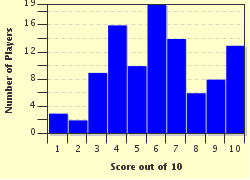Quiz Answer Key and Fun Facts
1. Approximately what percentage of conjoined twins are female?
2. There are two theories to explain the formation of conjoined twins. One is fission. What does this mean?
3. Another theory to explain conjoined twinning is fusion. What does this mean?
4. Two factors determine how and where conjoined twins are connected. One is the degree to which the egg splits. What is the other?
5. What is the primary criterion for the classification of conjoined twins?
6. There is another form of conjoined twins, called parasitic or heteropagus twins. What is a parasitic twin?
7. At the age of 16, the Hensel conjoined twins each got something special. What?
8. What is unusual about the Hogan girls in British Colombia, Canada?
9. Which doctor headed the team which first successfully separated craniopagus (fused skull) conjoined twins?
10. What is the condition known as fetus in fetu?
Source: Author
Trufflesss
This quiz was reviewed by FunTrivia editor
WesleyCrusher before going online.
Any errors found in FunTrivia content are routinely corrected through our feedback system.

